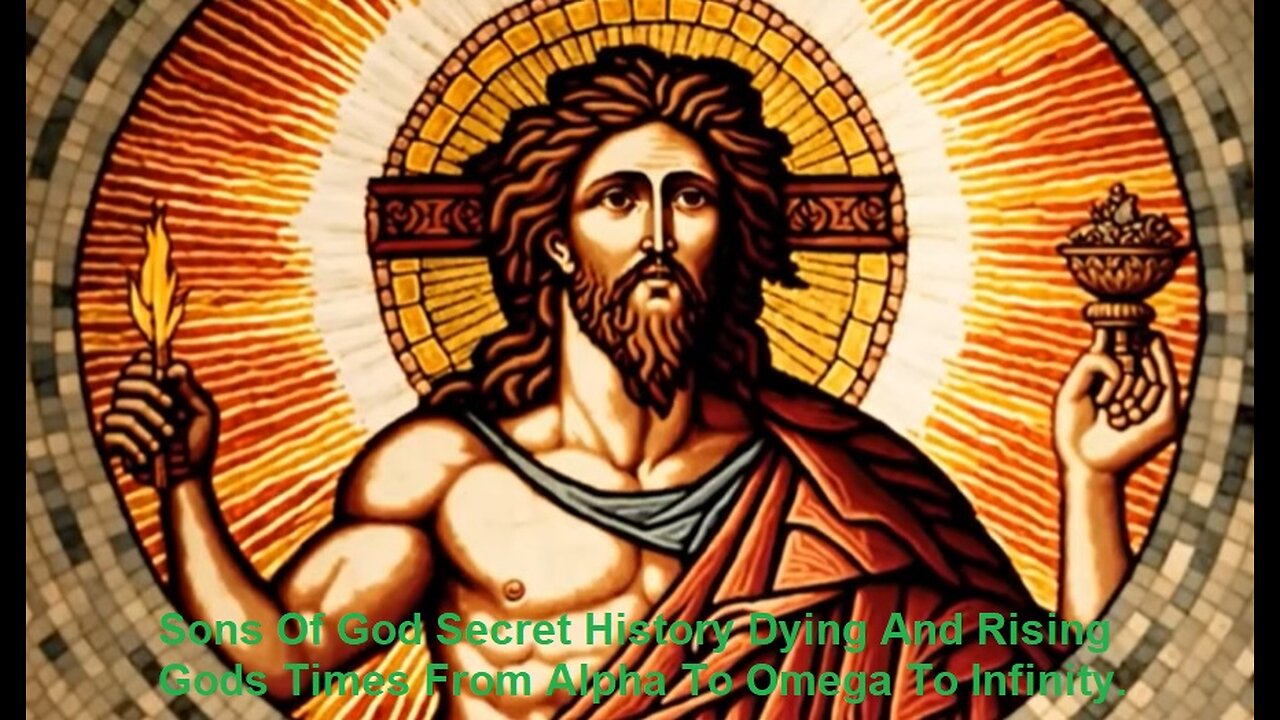Premium Only Content

Sons Of God Secret History Dying And Rising Gods From Alpha To Omega To Infinity.
In This 6.5 Hrs. Full Documentary With Sound Is About Ancient Sons of God Secret History Dying And Rising Gods From Alpha To Omega To Infinity. This Is The Most Important Set 21 Videos You Will Ever Watch. (21 Video Links In Text) We break down the most ancient forms of nature worship, to As applied in the scholarly literature, "dying and rising gods" is a generic appellation for a group of male deities found in agrarian Mediterranean societies who serve as the focus of myths and rituals that allegedly narrate and annually represent their death and resurrection.
Beyond this sufficient criterion, dying and rising deities were often held by scholars to have a number of cultic associations, sometimes thought to form a "pattern." They were young male figures of fertility; the drama of their lives was often associated with mother or virgin goddesses; in some areas, they were related to the institution of sacred kingship, often expressed through rituals of sacred marriage; there were dramatic reenactments of their life, death, and putative resurrection, often accompanied by a ritual identification of either the society or given individuals with their fate.
The category of dying and rising gods, as well as the pattern of its mythic and ritual associations, received its earliest full formulation in the influential work of James G. Frazer The Golden Bough, especially in its two central volumes, The Dying God and Adonis, Attis, Osiris. Frazer offered two interpretations, one euhemerist, the other naturist. In the former, which focused on the figure of the dying god, it was held that a (sacred) king would be slain when his fertility waned. This practice, it was suggested, would be later mythologized, giving rise to a dying god. The naturist explanation, which covered the full cycle of dying and rising, held the deities to be personifications of the seasonal cycle of vegetation. The two interpretations were linked by the notion that death followed upon a loss of fertility, with a period of sterility being followed by one of rejuvenation, either in the transfer of the kingship to a successor or by the rebirth or resurrection of the deity.
There are empirical problems with the euhemerist theory. The evidence for sacral regicide is limited and ambiguous; where it appears to occur, there are no instances of a dying god figure. The naturist explanation is flawed at the level of theory. Modern scholarship has largely rejected, for good reasons, an interpretation of deities as projections of natural phenomena.
Nevertheless, the figure of the dying and rising deity has continued to be employed, largely as a preoccupation of biblical scholarship, among those working on ancient Near Eastern sacred kingship in relation to the Hebrew Bible and among those concerned with the Hellenistic mystery cults in relation to the New Testament.
Despite the shock this fact may deal to modern Western religious sensibilities, it is a commonplace within the history of religions that immortality is not a prime characteristic of divinity: Gods die. Nor is the concomitant of omnipresence a widespread requisite: Gods disappear. The putative category of dying and rising deities thus takes its place within the larger category of dying gods and the even larger category of disappearing deities. Some of these divine figures simply disappear; some disappear only to return again in the near or distant future; some disappear and reappear with monotonous frequency. All the deities that have been identified as belonging to the class of dying and rising deities can be subsumed under the two larger classes of disappearing deities or dying deities. In the first case, the deities return but have not died; in the second case, the gods die but do not return. There is no unambiguous instance in the history of religions of a dying and rising deity.
The rituals of Adonis, held during the summer months, are everywhere described as periods of intense mourning. Only late texts, largely influenced by or written by Christians, claim that there is a subsequent day of celebration for Adonis having been raised from the dead. The earliest of these is alleged to be the second-century account of Lucian (Syrian Goddess 6–7) that, on the third day of the ritual, a statue of Adonis is "brought out into the light" and "addressed as if alive"; but this is an ambiguous report. Lucian goes on to say that some think the ritual is not for Adonis but rather for some Egyptian deity. The practice of addressing a statue "as if alive" is no proof of belief in resurrection; rather it is the common presupposition of any cultic activity in the Mediterranean world that uses images. Besides, Lucian reports that after the "address" women cut their hair as a sign of mourning.
DYING AND RISING GODS
DYING AND RISING GODS . The category of dying and rising gods, once a major topic of scholarly investigation, must now be understood to have been largely a misnomer based on imaginative reconstructions and exceedingly late or highly ambiguous texts.
Definition
As applied in the scholarly literature, "dying and rising gods" is a generic appellation for a group of male deities found in agrarian Mediterranean societies who serve as the focus of myths and rituals that allegedly narrate and annually represent their death and resurrection.
Beyond this sufficient criterion, dying and rising deities were often held by scholars to have a number of cultic associations, sometimes thought to form a "pattern." They were young male figures of fertility; the drama of their lives was often associated with mother or virgin goddesses; in some areas, they were related to the institution of sacred kingship, often expressed through rituals of sacred marriage; there were dramatic reenactments of their life, death, and putative resurrection, often accompanied by a ritual identification of either the society or given individuals with their fate.
The category of dying and rising gods, as well as the pattern of its mythic and ritual associations, received its earliest full formulation in the influential work of James G. Frazer The Golden Bough, especially in its two central volumes, The Dying God and Adonis, Attis, Osiris. Frazer offered two interpretations, one euhemerist, the other naturist. In the former, which focused on the figure of the dying god, it was held that a (sacred) king would be slain when his fertility waned. This practice, it was suggested, would be later mythologized, giving rise to a dying god. The naturist explanation, which covered the full cycle of dying and rising, held the deities to be personifications of the seasonal cycle of vegetation. The two interpretations were linked by the notion that death followed upon a loss of fertility, with a period of sterility being followed by one of rejuvenation, either in the transfer of the kingship to a successor or by the rebirth or resurrection of the deity.
There are empirical problems with the euhemerist theory. The evidence for sacral regicide is limited and ambiguous; where it appears to occur, there are no instances of a dying god figure. The naturist explanation is flawed at the level of theory. Modern scholarship has largely rejected, for good reasons, an interpretation of deities as projections of natural phenomena.
Nevertheless, the figure of the dying and rising deity has continued to be employed, largely as a preoccupation of biblical scholarship, among those working on ancient Near Eastern sacred kingship in relation to the Hebrew Bible and among those concerned with the Hellenistic mystery cults in relation to the New Testament.
Broader Categories
Despite the shock this fact may deal to modern Western religious sensibilities, it is a commonplace within the history of religions that immortality is not a prime characteristic of divinity: Gods die. Nor is the concomitant of omnipresence a widespread requisite: Gods disappear. The putative category of dying and rising deities thus takes its place within the larger category of dying gods and the even larger category of disappearing deities. Some of these divine figures simply disappear; some disappear only to return again in the near or distant future; some disappear and reappear with monotonous frequency. All the deities that have been identified as belonging to the class of dying and rising deities can be subsumed under the two larger classes of disappearing deities or dying deities. In the first case, the deities return but have not died; in the second case, the gods die but do not return. There is no unambiguous instance in the history of religions of a dying and rising deity.
The Deities
The list of specific deities to whom the appellation "dying and rising" has been attached varies. In most cases, the decipherment and interpretation of texts in the language native to the deity's cult has led to questions as to the applicability of the category. The majority of evidence for Near Eastern dying and rising deities occurs in Greek and Latin texts of late antiquity, usually post-Christian in date.
Adonis
Despite the original Semitic provenance of Adonis, there is no native mythology. What is known depends on later Greek, Roman, and Christian interpretations.
There are two major forms of the Adonis myth, only brought together in late mythographical tradition (e.g., the second-century ce Bibliotheca, falsely attributed to Apollodorus of Athens). The first, which may be termed the Panyasisian form, knows only of a quarrel between two goddesses (Aphrodite and Persephone) for the affections of the infant Adonis. Zeus or Calliope decrees that Adonis should spend part of the year in the upperworld with the one, and part of the year in the lowerworld with the other. This tradition of bilocation (similar to that connected with Persephone and, perhaps, Dumuzi) has no suggestion of death and rebirth. The second, more familiar Ovidian form narrates Adonis's death by a boar and his commemoration by Aphrodite in a flower. There is no suggestion of Adonis rising. The first version lacks an account of Adonis's death; the second emphasizes the goddess's mourning and the fragility of the flower that perpetuates his memory. Even when the two versions are combined, Adonis' alternation between the upper and lower worlds precedes his death.
The rituals of Adonis, held during the summer months, are everywhere described as periods of intense mourning. Only late texts, largely influenced by or written by Christians, claim that there is a subsequent day of celebration for Adonis having been raised from the dead. The earliest of these is alleged to be the second-century account of Lucian (Syrian Goddess 6–7) that, on the third day of the ritual, a statue of Adonis is "brought out into the light" and "addressed as if alive"; but this is an ambiguous report. Lucian goes on to say that some think the ritual is not for Adonis but rather for some Egyptian deity. The practice of addressing a statue "as if alive" is no proof of belief in resurrection; rather it is the common presupposition of any cultic activity in the Mediterranean world that uses images. Besides, Lucian reports that after the "address" women cut their hair as a sign of mourning.
Considerably later, the Christian writers Origen and Jerome, commenting on Ezekiel 8:14, and Cyril of Alexandria and Procopius of Gaza, commenting on Isaiah 18:1, clearly report joyous festivities on the third day to celebrate Adonis (identified with Tammuz) having been "raised from the dead." Whether this represents an interpretatio Christiana or whether late third- and fourth-century forms of the Adonis cult themselves developed a dying and rising mythology (possibility in imitation of the Christian myth) cannot be determined. This pattern will recur for many of the figures considered: an indigenous mythology and ritual focusing on the deity's death and rituals of lamentation, followed by a later Christian report adding the element nowhere found in the earlier native sources, that the god was resurrected.
The frequently cited "gardens of Adonis" (the kepoi) were proverbial illustrations of the brief, transitory nature of life and contain no hint of rebirth. The point is that the young plant shoots rapidly wither and die, not that the seeds have been "reborn" when they sprout.
Finally, despite scholarly fantasies, there is no evidence for the existence of any mysteries of Adonis whereby the member was identified with Adonis or his fate.
Aliyan Baal
The Ras Shamra texts (late Bronze Age) narrate the descent into the underworld of the puissant deity Aliyan Baal ("the one who prevails; the lord") and his apparent return. Unfortunately, the order of the incidents in the several different texts that have been held to form a Baal cycle is uncertain. The texts that are of greatest relevance to the question of whether Aliyan Baal is correctly to be classified as a dying and rising deity have major lacunae at the most crucial points. Although these texts have been reconstructed by some scholars using the dying and rising pattern, whether these texts are an independent witness to that pattern remains an open question.
In the major narrative cycle, Baal, having won the rulership by vanquishing the dangerous waters, is challenged by Mot, ruler of the underworld, to descend into his realm. After some initial hesitation, and after copulating with a cow, Baal accepts the challenge and goes down to the lower realm, whence it will be said of him that he is as if dead. After a gap of some forty lines, Baal is reported to have died. Anat descends and recovers his corpse, which is properly buried; a successor to Baal is then appointed, and Anat seeks out and kills Mot. After the narrative is interrupted by another forty-line gap, El declares, on the basis of a symbolic dream, that Baal still lives. After another gap of similar length, Baal is described as being in combat with a group of deities. As is apparent from this brief summary, much depends on the order of incidents. As it stands, the text appears to be one of a descent to the underworld and return—a pattern not necessarily equivalent to dying and rising. Baal is "as if he is dead"; he then appears to be alive.
In another, even more fragmentary Hadad cycle (Hadad being identified with Baal), Hadad goes off to capture a group of monsters, but they, in turn, pursue him. In order to escape he hides in a bog, where he lies sick for seven years while the earth is parched and without growth. Hadad's brothers eventually find him and he is rescued. This is a disappearing-reappearing narrative. There is no suggestion of death and resurrection.
There is no evidence that any of the events narrated in these distressingly fragmentary texts were ritually reenacted. Nor is there any suggestion of an annual cycle of death and rebirth. The question whether Aliyan Baal is a dying and rising deity must remain sub judice.
Attis
The complex mythology of Attis is largely irrelevant to the question of dying and rising deities. In the old, Phrygian version, Attis is killed by being castrated, either by himself or by another; in the old Lydian version, he is killed by a boar. In neither case is there any question of his returning to life. There is a second series of later traditions that deny that Attis died of his wounds but do not narrate his subsequent death or, for that matter, his rebirth. Finally, two late, post-Christian theological reflections on the myth hint at rebirth: the complex allegory in the Naassene Sermon and the euhemerist account in Firmacus Maternus, in which a pretended resurrection is mentioned. Attis is not, in his mythology, a dying and rising deity; indeed, he is not a deity at all.
All of the attempts in the scholarly literature to identify Attis as a dying and rising deity depend not on the mythology but rather on the ritual, in particular a questionable interpretation of the five-day festival of Cybele on March 22–27. The question of the relationship between the Day of Blood (March 24) and the Day of Joy (March 25) caught the attention of some scholars, who, employing the analogy of the relationship of Good Friday to Easter Sunday, reasoned that if among other activities on the Day of Blood there was mourning for Attis, then the object of the "joy" on the following day must be Attis's resurrection. Unfortunately, there is no evidence that this was the case. The Day of Joy is a late addition to what was once a three-day ritual in which the Day of Blood was followed by a purificatory ritual and the return of the statue of the goddess to the temple. Within the cult, the new feast of the Day of Joy celebrates Cybele. The sole text that connects the Day of Joy with Attis is a fifth-century biography of Isidore the Dialectician by the Neoplatonic philosopher Damascius, who reports that Isidore once had a dream in which he was Attis and the Day of Joy was celebrated in his honor!
Scholars have frequently cited a text in Firmacus Maternus (22.3) as referring to Attis and his resurrection on the Day of Joy: "Be of good cheer, you of the mysteries, your god is saved!" However, the god is unidentified, and the notion of "cheer" is insufficient to link this utterance to Attis and the Day of Joy. The text most probably reflects a late antique Osirian ritual.
Neither myth nor ritual offers any warrant for classifying Attis as a dying and rising deity.
Marduk
The figure of the king-god of Babylon, Marduk, has been crucial to those scholars associated with the Myth and Ritual school as applied to the religions of the ancient Near East. For here, as in no other figure, the central elements of their proposed pattern appear to be brought together: the correlation of myth and ritual, the annual celebration of the dying and rising of a deity, paralleled by an annual ritual death and rebirth of the king. Marduk is the canonical instance of the Myth and Ritual pattern.
In 1921, F. Thureau-Dangin published the text, transcription, and translation of a Seleucid era text, preserved in two copies, presenting a part of the ritual for the New Year festival (the Akitu) in Babylon. Despite a large number of references to the performance of the ritual in Babylonian texts (although not always to the Akitu associated with Marduk or Babylon) and scattered mentions of individual items in the ritual, this exceedingly late cuneiform text is the only detailed description of the ritual program in Babylon to survive. It enjoins twenty-six ritual actions for the first five days of the twelve-day ceremony, including a double reading of a text entitled Enuma elish. Assuming that this reference is to some form of the text now known by that name, the "Babylonian creation epic" as reconstructed by contemporary scholarship, the ritual suggests a close link to the myth. However, not one of the twenty-six ritual actions bears the slightest resemblance to any narrative element in the myth. Whatever the significance of the recitation of the text during the Akitu festival, the myth is not reenacted in that portion of the ceremonies that has survived.
Realizing this, some proponents of the Myth and Ritual approach have argued that the first five days of the ritual were only purificatory in nature, and go on to speculate that the next three days of the festival featured a dramatic reenactment of a myth of the death and resurrection of Marduk. This sort of imaginative speculation gave rise to a new set of problems. There is no hint of Marduk's death in the triumphant account of his cosmic kingship in Enuma elish. If some such myth was enacted, it was not the one stipulated in the ritual program. Nevertheless, scholars turned to a cuneiform text that they entitled The Death and Resurrection of Bel-Marduk. The title is somewhat misleading. There are sixteen episodes in the text, which appears to narrate Marduk's imprisonment. The text is fragmentary and difficult to interpret, but it appears to be in the form of a ritual commentary in which a set of ritual gestures are correlated to events in a subtextual narrative of Marduk's capture.
For an older generation of scholars, Marduk's imprisonment was equivalent to his death, and his presumed ultimate release represented his resurrection. More recent interpretations have minimized the cosmic symbolism: Marduk has been arrested and is being held for trial. By either reading, such a narrative of the king-god's weakness or crime would appear odd in a Babylonian setting. This caution is strengthened by the fact that the text is of Assyrian provenance and is written in the Assyrian dialect. It is not a native Babylonian text and could have played no role in the central festival of Babylon.
The so-called Death and Resurrection of Bel-Marduk is most likely an Assyrian political parody of some now unrecoverable Babylonian ritual composed after the Assyrians conquered Babylon in 691/689 bce. At that time, the statue of Marduk was carried off into Assyrian captivity. From one point of view, the text has a simple, propagandistic message: Compared to the gods of Ashur, Marduk is a weak deity. More subtly, for those Assyrians who held Marduk in some reverence, the notion of his crimes would provide religious justification for his capture.
The notion that the king undergoes an annual ritual of mimetic dying and rising is predicated on the fact that the deity, whose chief representative is the king, is believed to undergo a similar fate. If it is doubtful that Marduk was understood as a dying and rising deity, it is also doubtful that such a ritual was required of the king. Some scholars have held that the so-called ritual humiliation of the king on the fifth day of the New Year festival, with its startling portrayal of the king being dethroned, slapped, pulled by the ears, and reenthroned, is symbolic of his death and resurrection. But such an interpretation ignores both the manifest content of the ritual text and its date. During the humiliation ceremony, the king is required to recite a negative confession: that he did not overthrow his capital city of Babylon or tear down its walls, that he did not insult its protected citizens, that he did not neglect or destroy its central temple.
From one point of view, such a negative confession is ludicrous. What native Babylonian king ever contemplated, much less carried out, such actions? These were the actions of foreign kings (Assyrian, Persian, Seleucid) who gained the throne of Babylon by conquest and desecrated the native cult. However, as with Cyrus among the Israelites, so too for the Babylonians, foreign kings could be named who restored Babylon and its temple. Read in this light, the ritual humiliation of the king appears to be a piece of Babylonian nationalistic ritual rectification: Good fortune and continued kingship comes to the (foreign) king if he acts as a pious (native) king would act. If not, he will be stripped of his kingship.
This understanding is made more plausible by the date of the only surviving texts of the ritual. They are all from the Hellenistic Seleucid period, that is to say, from a period after the ending of native kingship and the installing of foreign kings on the throne. The pattern may be earlier, dating back, perhaps, to the time of Sargon II (r. 721–705 bce), the earliest conqueror of Babylon to adopt consciously the Babylonian etiquette of kingship and during whose rule, for the first time, one finds legal texts guaranteeing Assyrian recognition of the rights and privileges of the "protected citizens" of Babylon. In the present text of the New Year ritual, a set of actions designed to deal with the more proximate Assyrian conquerors has been reapplied to the relatively more foreign Seleucid rulers.
There is no evidence that the Babylonian Marduk was ever understood to be a dying and rising deity, that such a myth was reenacted during the New Year festival, or that the king was believed to undergo a similar fate.
Osiris
In contrast to the other deities considered above, Osiris has a thick textual dossier stretching over millennia. Although the full, connected myth is only to be found in Greek, in Plutarch's Isis and Osiris from the early second century ce, the Osirian myth can be reconstructed from the Pyramid Texts of the fifth and sixth dynasties. While the names of the actors and details of the incidents vary, this record is remarkably consistent over twenty-five hundred years. Osiris was murdered and his body dismembered and scattered. The pieces of his body were recovered and rejoined, and the god was rejuvenated. However, he did not return to his former mode of existence but rather journeyed to the underworld, where he became the powerful lord of the dead. In no sense can Osiris be said to have "risen" in the sense required by the dying and rising pattern; most certainly it was never conceived as an annual event. The repeated formula "Rise up, you have not died," whether applied to Osiris or a citizen of Egypt, signaled a new, permanent life in the realm of the dead.
Osiris was considered to be the mythical prototype for the distinctive Egyptian process of mummification. Iconographically, Osiris is always depicted in mummified form. The descriptions of the recovery and rejoining of the pieces of his body are all elaborate parallels to funerary rituals: the vigil over his corpse, the hymns of lamentation, the embalmment (usually performed by Anubis), the washing and purification of the corpse, the undertaking of the elaborate ritual of the "opening of the mouth" with its 107 separate operations, as well as other procedures for reanimation, the dressing of the body, and the pouring out of libations. Through these parallels, the individual Egyptian dead became identified with, and addressed as, Osiris (perhaps earliest in Pyramid Texts 167a–168a). The myth and ritual of Osiris emphasizes the message that there is life for the dead, although it is of a different character than that of the living. What is to be feared is "dying a second time in the realm of the dead" (Book of Going Forth by Day 175–176).
Osiris is a powerful god of the potent dead. In no sense can the dramatic myth of his death and reanimation be harmonized to the pattern of dying and rising gods.
Tammuz/Dumuzi
The assessment of the figure of Tammuz (Sumerian, Dumuzi) as a dying and rising deity in the scholarly literature has varied more than any other deity placed in this class. For example, within a thirty-year period, one of the most significant scholars in the field, the Sumeriologist Samuel Noah Kramer, has revised his judgment regarding this question several times. Before 1950, Kramer thought it possible that Dumuzi was freed from death; between 1950 and 1965, he considered Dumuzi to be solely a dying god; since 1966, he has been willing to speak again of the "death and resurrection" of Dumuzi.
The ritual evidence is unambiguously negative. During the summer month of Tammuz, there was a period of wailing and lamentation for the dead deity. A substantial number of cultic hymns of mourning, going back to the second millennium bce, have been recovered; by the sixth century bce, the ritual was practiced in Jerusalem (Ez. 8:14); in Syria, it is witnessed to as late as the fifth century ce and, in variations, persisted through medieval times. If third-century Christian authors are to be trusted, the figure of Tammuz interacted with that of Adonis in Asia Minor. In all of these varied reports, the character of the ritual is the same. It is a relentlessly funereal cult. The young Tammuz is dead, and he is mourned. His life was like that of the shoot of a tender plant. It grows quickly and then withers away. It was a life that is "no more"—a persistent refrain in the lamentations. There is no evidence for any cultic celebration of a rebirth of Tammuz apart from late Christian texts where he is identified with Adonis.
Given the predilection of scholars concerned with Christian origins for a pre-Christian pattern of dying and rising deities, it comes as no surprise that, despite the lack of cultic evidence, it was widely supposed that the period of mourning for Tammuz must have been followed by a festival of rejoicing. This speculative conclusion seemed to gain support with the publication of the Akkadian Descent of Ishtar from the library of Ashurbanipal in Nineveh. The text narrates the descent of the goddess into the underworld and her return. However, the concluding nine lines of the text contain a series of enigmatic references to Tammuz, Ishtar's youthful lover, in the land of the dead. Although the text nowhere mentions it, scholars supposed that the purpose of Ishtar's descent was to bring Tammuz up. If so, this would place Tammuz securely within the dying and rising pattern.
Even on the basis of the Akkadian text alone, such an interpretation is unlikely. There is no connection stated in the text between Ishtar's descent and Tammuz. (Indeed, some scholars have suggested that the last lines referring to Tammuz were originally independent and added to the Descent as a scribal gloss.) Even more detrimental to the dying and rising hypothesis, the actions performed on Tammuz in these three strophes are elements from the funeral ritual. Ishtar is treating Tammuz as a corpse. Finally, the line rendered in the earlier translations as "on the day when Tammuz comes up" has been shown to be a mistranslation. It either refers to Tammuz greeting Ishtar (i. e., coming up to her) in the underworld, or it is a reference to the month Tammuz. In the Akkadian version, Tammuz is dead and remains so. Such an understanding is witnessed to in other Akkadian texts. For example, in the Epic of Gilgamesh (6.46–50), the hero insults and scorns Ishtar, reminding her that all her previous lovers—Tammuz heads the list—have died as a result of their relationship to her.
Such considerations seemed to become purely academic with the publication of the Sumerian prototype of the Akkadian text, Inanna's Descent to the Netherworld (Inanna is the Sumerian form of Ishtar) and the closely related Death of Dumuzi. These early texts made clear that the goddess did not descend to the realm of the dead to rescue her consort. Rather it was her descent that was responsible for his death.
Inanna, the queen of heaven, sought to extend her power over the underworld, ruled by her sister, Ereshkigal. As in the Akkadian text, Inanna descends through seven gates, at each removing an article of clothing or royal regalia until, after passing through the seventh gate, she is naked and powerless. She is killed and her corpse hung on a hook. Through a stratagem planned before her descent, she is revived, but she may not return above unless she can find a substitute to take her place. She reascends, accompanied by a force of demons who will return her to the land of the dead if she fails. After allowing two possible candidates to escape, she comes to Erech, where Dumuzi, the shepherd king who is her consort, appears to be rejoicing over her fate. She sets the demons on him, and after he escapes several times, he is captured, killed, and carried off to the underworld to replace Inanna. In this narrative, Dumuzi is a dying god.
In 1963 a new portion of the Descent of Inanna was announced. Here, it would appear, there is yet a further episode. Inanna, in response to Dumuzi's weeping, decrees an arrangement whereby Dumuzi will take her place for half the year in the underworld and then return to the realm of the living; his sister, Geshtinanna, will then take Dumuzi's place in the underworld for the other half of the year, and, likewise, return.
For some scholars, this new conclusion to Inanna's Descent was sufficient to restore Dumuzi/Tammuz to the class of dying and rising gods. Such an understanding is unlikely. The myth emphasizes the inalterable power of the realm of the dead, not triumph over it. No one ascends from the land of the dead unless someone takes his or her place. The pattern of alternation—half a year below, half a year above—is familiar from other myths of the underworld in which there is no question of the presence of a dying and rising deity (e.g., Persephone, as in Ovid, Fasti 4.613–4, or the youthful Adonis as described above), and is related, as well, to wider folkloristic themes of death delayed if a substitute can be found (e.g., Stith Thompson, Motif-Index A 316; D 1855.2; P 316). Such alternation is not what is usually meant in the literature when speaking of a deity's "rising."
As the above examples make plain, the category of dying and rising deities is exceedingly dubious. It has been based largely on Christian interest and tenuous evidence. As such, the category is of more interest to the history of scholarship than to the history of religions.
CASTRATION
CASTRATION . Castration is a custom found both in mythological tales and in ritual practices of peoples of various origins, cultural levels, and geographical locations. Because there is a preponderance of documentation of the custom in the ancient Near East and Mediterranean cultures, the origin and propagating center of this custom has often been ascribed to ancient Semitic culture. But evidence of castration has also been found in other, different cultures that were never influenced by Semitic culture, which seems to rule out a hypothesis of diffusion. Besides, the act of castration, both mythological and ritual, is naturally connected with other practices, beliefs, and doctrines that are all related in some way to sex and sexuality. Their connections (with circumcision, bisexuality, virginity, and celibacy) constitute a kind of compact but multivariegated "symbolic universe."
Myths
Many of the cosmogonic myths are based on two cosmic entities, Sky and Earth, who are originally united in a sexual embrace from which violent action alone can separate them. A tale of the Maori in New Zealand says that offspring born of the endless mating of Rangi ("sky") and Papa ("earth") are held in darkness and spacelessness. Finally the offspring decide to separate their parents, cutting the father's "tendons" (probably a euphemism) and pushing him up to achieve the present separation of sky and earth. The cosmogonic motif of the primordial couple is found in almost all Oceanic civilizations and widely in Africa and the Americas. But the act of violent separation of the two cosmic entities is seldom clearly described as a real act of castration, even if its symbolic verisimilitude leads one to think of it in this way. An example of castration presented in a straightforward manner is in the Greek cosmogonic myth, Hesiod's Theogony. The god Ouranos ("sky") and the goddess Gaia ("earth") conceive a breed of divine beings, but the god exhausts his paternal role in procreation and keeps his children from any kind of activity, thrusting them again into their mother's womb. At last one of them, Kronos, makes an ambush and cuts off his father's sexual organ, throwing it behind his own back. The goddess Gaia is fertilized by the blood of Ouranos, while from his sexual organ, which falls into the sea, is born the goddess of love, Aphrodite. Thus the only way to eliminate Ouranos, whose existence consisted of mere sexual and procreative activity, was to castrate him: this is the only opportunity to "murder," in some sense, an immortal god. This castration is a positive event because it breaks the cycle of endless and useless reproduction and gives Ouranos's offspring a living space between sky and earth. It represents moreover a fundamental moment in the establishment of the real and ordered world. From the morphological point of view, the myth of Ouranos's castration is typical of the image of the heavenly divine being who, after his initial performance, leaves the stage, becoming a deus otiosus.
Comparative analysis has pointed out important resemblances to the myth of the impotence of Varuṇa, an Indo-Iranian god, and also to the investiture ritual of the king in India (Dumézil, 1948). Analogies exist also with the Navajo creation myth (Dine Bahane ), in which the First Woman gives birth to twins with her husband. These twins, who are nadleeh (intersexed, neither male nor female), ordered the world, slayed the dragons, and invented pottery and all sort of tools. Historical analysis, on the other hand, has indicated some parallel cases in cosmogonic myths of the ancient Near East. The Mesopotamian creation epic, Enuma elish, tells of the god Enki, who defeats and annihilates his enemy Mummu, taking off his crown, smashing his head, and finally cutting off his penis. The Hittite myth of Kumarbi contains even more similarities to Ouranos's story. This cosmogony, combining one of the earliest Hurrian stories with some elements of Assyro-Babylonian mythology, deals with a succession of children's rebellions against their fathers. In this myth Kumarbi pursues his father, Anu, who seeks safety by flying toward the sky, but the son grabs his father's feet, dragging him to the ground. Then, seized by excitement, Kumarbi bites his father's penis, tears it off, and swallows it, laughing and boasting of his bravado. But the swallowed sexual organ makes him pregnant with terrifying gods who will soon defeat him in turn.
Scholars are in agreement that the similarity between Greek and Hittite myths can be explained as an indication of direct historical derivation on the grounds of similar general structure and the common presence of castration. Nevertheless there are significant differences between these myths, and there remains a notable uncertainty about how the motif spread. A recurrence of Ouranos's castration can be found in the cosmogony of Philo of Byblos, a late Phoenician author who claims a reference to Sanchuniathon, an ancient Phoenician author. Mixing local information with Greek conceptions in a syncretic and euhemeristic way, Philo ascribes to the god El-Kronos an act of castration against his father. The Hellenic pattern is clearly apparent, but archaeological discoveries at Ugarit (Ras Shamra) in Phoenicia, dating from the second millennium bce, seem to confirm to some extent the authenticity and antiquity of the myth. In a different case in the Prose Edda, an ancient Germanic cosmogony, the "father of everything," a personal entity with creative power, is also called "the castrated" with no further explanation. Scholars agree that many features of this divine being are not original but derived from Christian influences, and they think also that the castration element can be dated back to the earliest Greek tradition of Ouranos.
Besides these cosmogonic myths other kinds of myths in which castration constitutes a pattern of ritual action deserve mention. The close connection between myth and rite in these cases arouses the rightful suspicion that the myth may have been constructed in order to provide a motivation for the ritual practice. The most famous myth is the Greco-Roman story of the goddess Cybele and the god Attis. Cybele, venerated in Rome and in the Roman Empire under the name of Great Mother (Magna Mater), was an ancient goddess of fertility known in Anatolia since the second millennium bce under the name of Kubaba. Some iconographic and onomastic evidence suggests an even more remote origin going back to the Anatolian Neolithic and perhaps Mesopotamian civilization. The young servant-lover Attis, on the other hand, seems to have been introduced along with his mate only after the arrival in Anatolia of the Phrygians (c. eighth century bce). There are several mythical versions of Attis's castration (Hepding, 1903/1967). It is easy to follow a constant line of development from more ancient tales—much more intricate and grotesque—to the embellished and romantic later versions. The original stories take place in an environment of unnatural primitiveness, monstrous procreations, violent loves, and bloody punishments. All these versions culminate in the story of Attis, who castrates himself in a fit of madness or out of a desire for absolute chastity. Sometimes Attis's castration is attributed to a wild boar or to a jealous entity who wants to punish him for his amorous exploits.
Similar is the Egyptian myth of the mystical couple Isis and Osiris, but here the mythical castration apparently does not constitute a pattern of ritual action. The god Osiris was dismembered, and fourteen pieces of his body were strewn all over Egypt. His wife, the goddess Isis, found the body. But Osiris's penis was thrown into the Nile and eaten by a fish, so Isis is forced to construct with sycamore wood a facsimile of his phallus. The Phoenician and Cypriot and in any case Semitic Adonis that lives out his short season seducing and being seduced by Aphrodite, whose vitality is overpowering, bled to death in a boar hunt. But his castration is only hypothetical, and above all there is no evidence that his priests practiced ritual castration. Two basic events, emasculation and death, therefore mark the mythical personalities of these young gods (but only problematically the concrete ritual castration of their followers) and signify the depotentiation of divine life and its inevitable repercussions on the life of the cosmos, which seems to imitate the vicissitude of the divine body (Casadio, 2003).
Rituals
The documentation related to ritual practices records, first of all, that the act of castration can sometimes be the result of temporary exaltation or religious fanaticism. The religio-historical as well as ethnographic literature cites some examples, but their rarity and especially their complete isolation from myths, doctrines, and institutionalized interpretations make them subjects for studies in psychology (or psychopathology). The history of religions, on the other hand, is concerned with institutionalized acts of castration, for instance, within the so-called pubertal cults. All these practices belong to a broader category of ritual mutilations, like the custom of removal of one testicle, which is practiced almost exclusively among Camitic populations in Africa, where it seems to serve as a substitute for circumcision, a practice completely unknown to them. In the initiation rites of primitive peoples different practices involving male genitalia are frequent (circumcision, subincision), as are those involving female genitalia (clitoridectomy, infibulation), and their origin and significance seem rather difficult to establish. According to some scholars, these practices constitute symbolic equivalents of castration.
Another category of castration is the custom, widespread in the ancient Near East and in Semitic cultures, of castrated priests. The kurgarru, for instance, is a eunuch priest of Ishtar who officiates at the orgiastical rites in honor of the god Marduk. Many of the clergy of Hekate in Stratonicea, Caria, and in Laginas and the clergy of Artemis in Ephesus and of Atargatis in Hierapolis, Syria, were castrated. Some sporadic cases of analogous priestly castration have been reported in Brahmanic India, particularly in the northern mountains, and also in Nepal and Tibet. Usually the castrated priests are connected with a powerful and fertile goddess, sometimes with astral characteristics, and at other times with the features of a goddess of animals, who is conventionally called Mother Goddess.
Finally, there is a series of examples in which the ritual of castration appears entirely institutionalized, justified according to the myths of foundation or in accordance with precise beliefs and doctrines. Within the Cybele and Attis cult, the mythical castration of Attis is the foundation of the practice of castration of his priests (and perhaps of believers too), which is a kind of sacrament of consecration, a sacrifice recalling the god's passion, and sometimes a votive offering. The Galli—as these priests are most commonly called—dedicated themselves to the goddess Cybele after willingly castrating themselves during ritual performances in which, in a frenzy of dances, obsessive beating of drums, and self-flagellation, they reached paroxysms of exaltation. The Galli wore female clothing and heavy makeup, their hair was long and loose, and they lived in a wandering missionary community, supporting themselves with alms they received for offering predictions and prognostications. At Pessinus in Asia Minor they ruled sacerdotal city-states in which temples and royal palaces were unified. In Greece they were generally despised and driven away because of their mutilation and their appearance; they were never fully assimilated into official religion. In Rome, where the cult of Cybele was introduced in 204 bce, and in the Roman Empire they were at first strictly regulated and controlled by the state; then they acquired, little by little, more importance and autonomy. The Roman distaste for eunuchism slowly faded away because of the approval of some emperors of the practice and because of a certain lessening of bloodier and crueler aspects of the cult.
Thus the cult of Cybele and Attis had its temples and its brotherhood in Rome, and its feasts included in the sacral calendar. Little by little, under the influence of a certain spiritualism and new symbolic interpretations, the cult assumed a mystic character and became a kind of mystery cult like other cults of Oriental origin. The castration of believers was easily explained as a sign of the search for perfection, a voluntary renunciation of the pleasures of the flesh, and the Attis figure became more and more spiritualized. During the later Roman Empire the self-castration of believers was probably replaced or integrated into the bloody and spectacular rite called the Taurobolium. A bull was slain and (probably) castrated, and its blood was shed over the believer as a lavation of intensified achievement, regenerative and purifying. Important mystical interpretations of relevant myths also were given in late antiquity by Naassene Gnostics, for example, by which "the mutilation of Attis means that he was separated from the low earthly regions of creation" (Cosi, 1986, pp. 111–113). For Julian the Apostate the castration of Attis means "a pause in the rush towards the infinite" (Cosi, 1986, pp. 111–113).
Castration appears sporadically in practices of groups, sects, and isolated thinkers that link it to doctrines preaching asceticism and sexual abstinence and regard it as an escape from the temptations of the flesh. Such doctrines—which have remarkable precedents and parallels within the pagan as well as the Judaic world—developed during the first centuries of the Christian era and were inclined to radicalize the pronouncement by Matthew on eunuchs (Mt. 19:12) as well as the orthodox position (of Paul, for instance) on the prestige of virginity. Strongly connected with sexual and marital morality, bound to the theme of ecclesiastical celibacy, and intertwined with the rise of monasticism, this topic is evinced in some authors as a preaching of the enkrateia (continence), understood as the complete rejection of any kind of sexual intercourse. If within the ecclesiastical and orthodox line virginity and chastity are recommended solely on the basis of motivations, such as the imitation of Christ or in anticipation of the kingdom of heaven, according to these doctrines sexual abstinence becomes a necessary condition of salvation and is based on ontological and protological motivations of the dualistic and Platonic mold. According to some writers, the Greek father Origen (third century ce) and other ecclesiastic authorities castrated themselves in order to extinguish definitively any desire for sexual intercourse. At the same time, in the mysterious sect of the Valesians (from Valesius, the founder), castration was a normal practice. Epiphanius, bishop of Salamis, refuted the sect and accused it of heresy. It also seems that among the Manichaeans the current obligation of chastity was transformed in some cases into the practice of self-castration. The phenomenon must have been rather widespread, because it was addressed by the Council of Nicaea (325 ce) and a bull of Pope Leo I (c. 395 ce).
A renewal of the practice of castration for the sake of proselytism and asceticism (a call to remove the "organs of sin") is found among the Skoptsy (the castrated), a Russian sectarian community that developed from the complex movement of the Raskol schism during the mid-eighteenth century. The Skoptsy were long persecuted, but they spread throughout Russia during the next century and survived in some Romanian peasant communities until 1950.
Origins
From this brief review of facts relative to castration in some myths and ritual practices, it becomes clear that even if the ancient Semitic (and Mediterranean) world offers the majority of the documentation and shows some cases of dependence and evolution, it cannot be considered the unique source of the diffusion of this practice. In the same way it is impossible to decide on a univocal interpretation of the practice of castration that can explain in all cases its causes and motivations. Sometimes the connection with themes of fertility and procreation is primary, so that castration of a "vegetation spirit" ("Dying and rising god," in the words of James George Frazer [1890, I, pp. 278–279]) constitutes a dramatic event stopping the flow of life or containing it within more orderly boundaries. "Functional" is otherwise the explanation provided by Walter Burkert (1979): the act of castration, producing neither man nor woman but "nothing," puts a man outside archaic society and makes apostasy impossible. At other times, on the basis of doctrinary principles, castration is instead related to a search for asexuality understood as a privileged condition. In some cases this asexuality resolves into a kind of symbolic bisexuality that aims to reproduce in the believer the powerful joint presence of both sexes that is found in certain androgynous primordial figures. Interpretations influenced by psychoanalysis have often been offered to explain these themes. Finally, in many cases castration is clearly demanded as an extreme form of mystical practice in currents of thought that celebrate abstention as a choice in life and as a condition of salvation.
CLITORIDECTOMY . The term clitoridectomy covers a range of ritual surgical operations: (1) drawing blood from the clitoral prepuce or removal of the prepuce, (2) excism of the clitoris, (3) excism of the clitoris and labia minora, and (4) infibulation, requiring removal of the clitoris, the labia minora, and the anterior two-thirds of the labia majora, the two sides of which are then joined so that a small posterior opening is left for the passage of urine and menstrual blood. The first type occurs in Islamic countries of the Middle East, Africa, and Asia. The second type occurs in East, West, and central Africa, on the Arabian Peninsula, and in Brazil, eastern Mexico, and Peru. The third type occurs throughout Africa, in Arab countries, and in parts of Aboriginal Australia. Infibulation occurs in Sudan, Ethiopia, Djibouti, Eritrea, southern Egypt, northern Nigeria, Mali, and the Central African Republic.
Alpha and Omega are the first and last letters in the Greek alphabet, representing the totality, the beginning, and the end, as well as the entire range of sounds and infinity. They are sometimes portrayed by the eagle and the owl, day and night, and are said to contain the key to the universe. The shape of Alpha is related to a pair of compasses, an attribute of God the creator, while Omega's shape is similar to a torch, the fire of apocalyptical destruction.
Real Timeline Of Deception Part 0 Exploring Tartaria 1000 Years
Exploring Tartaria - Old World Secrets Revealed
https://rumble.com/v2u8ef4-real-timeline-of-deception-part-0-exploring-tartaria-1000-years-added-to-ou.html
Real Timeline Of Deception Part 1 Exploring Tartaria 1000 Years
The Timeline Deception - Part I - Exploring Tartaria
https://rumble.com/v2ua8sa-real-timeline-of-deception-part-1-exploring-tartaria-1000-years-added-to-ou.html
Real Timeline Of Deception Part 2 Exploring Tartaria 1000 Years
The Timeline Deception - Part II - Exploring Tartaria
https://rumble.com/v2ubf4w-real-timeline-of-deception-part-2-exploring-tartaria-1000-years-added-to-ou.html
Real Timeline Of Deception Part 3 Exploring Tartaria 1000 Years
The King of Tartaria - Exploring Tartaria
https://rumble.com/v2ueih6-real-timeline-of-deception-part-3-exploring-tartaria-1000-years-added-to-ou.html
Real Timeline Of Deception Part 4 Exploring Tartaria 1000 Years
The Saints - Relics, Reliquaries, & The First Resurrection
https://rumble.com/v2ugl92-real-timeline-of-deception-part-4-exploring-tartaria-1000-years-added-to-ou.html
Real Timeline Of Deception Part 5 Exploring Tartaria 1000 Years
The Saints - The Ruling Class - Exploring Tartaria
https://rumble.com/v2uij7w-real-timeline-of-deception-part-5-exploring-tartaria-1000-years-added-to-ou.html
Real Timeline Of Deception Part 6 Exploring Tartaria 1000 Years
From Atheism, Agnosticism, New Age, Protestantism, to Roman Catholicism
https://rumble.com/v2ujvr6-real-timeline-of-deception-part-6-exploring-tartaria-1000-years-added-to-ou.html
Real Timeline Of Deception Part 7 Exploring Tartaria 1000 Years
The Millennial Kingdom of God - Exploring Tartaria
https://rumble.com/v2uldss-real-timeline-of-deception-part-7-exploring-tartaria-1000-years-added-to-ou.html
Real Timeline Of Deception Part 8 Exploring Tartaria 1000 Years
Magic of the White City 1893 Chicago World's Fair
https://rumble.com/v2un20g-real-timeline-of-deception-part-8-exploring-tartaria-1000-years-added-to-ou.html
Real Timeline Of Deception Part 9 Exploring Tartaria 1000 Years
1000 Years Added To Our History & Dark Ages Never Existed
https://rumble.com/v2uo07i-real-timeline-of-deception-part-9-exploring-tartaria-1000-years-added-to-ou.html
Real Timeline Of Deception Part 10 Exploring Tartaria 1000 Years
Church History - Complete Documentary AD 33 to Present
https://rumble.com/v2uprfu-real-timeline-of-deception-part-10-exploring-tartaria-1000-years-added-to-o.html
Real Timeline Of Deception Part 11 Exploring Tartaria 1000 Years
Christmas Unveiled - Pied Piper - Templars Secret - Saturn's Workshop - Giants Stealing Children
https://rumble.com/v2urmd0-real-timeline-of-deception-part-11-exploring-tartaria-1000-years-added-to-o.html
Real Timeline Of Deception Part 12 Exploring Tartaria 1000 Years
Ancient Cloning Factories - Foundlings - Incubators - Test-Tube Babies
https://rumble.com/v2uu8ck-real-timeline-of-deception-part-12-exploring-tartaria-1000-years-added-to-o.html
Real Timeline Of Deception Part 13 Exploring Tartaria 1000 Years
Homunculus Unveiled - Jesus - Artificial Generation - Liber Vaccae - Lost Esoteric Secrets
Archaix Chronology Anunnaki Sumerian Gods Crystalinks Timelines 2040B.C. 2046A.D.
Archaix 2.0 Doomsday Chronology Five color charts with extensive Legend-chronology; exhibits 62 dates involving 300 events in linear timeline combining the Phoenix and Nemesis X Object appearances, the Mayan Long-Count baktuns and the Anunnaki NER 600 year periods, a history spanning over 74 centuries to May 2040 and November 2046. Not on the chart but talked about in video are 21 additional dated events of things occurring in the world at key times within the 4 listed timelines. The BCE/CE dating system was first used in the 17th century and has been used since in scholarly publications read by people of all faiths and cultures in an effort to be inclusive. This system is also more accurate in that it makes no claim to date the year of Christ’s birth which no one knows.
I got over what I refer to as the "dual timelines" and go into a little detail about how they relate to each other. I try not to bore you with too many examples and technical details, but hopefully you get the idea!
A Must See Video What On Earth Happened Parts (14) All 13 Parts Together
Everything we were taught about the Earth, History, Science, Space, Energy and our Civilization was a lie. This mind blowing documentary will shift your perspective of the world monumentally.
0:00 - Part One: "Turning Inwards" - 7:19 - Part Two: "Of Maps and Magicians"
- 34:40 - Part Three: "Flattening the Curve" - 57:16 - Part Four: "Vanishing Points & the Old Clock" - 1:21:34 - Part Five: "The Red Shield" - 1:47:28 - Part Six: "Infiltration Instead of Invasion" - 2:11:36 - Part Seven: "Eyes Wide Open" -
3:01:55 - Part Eight: "The Looking Glass" - 3:59:06 - Part Nine: "Panic" - 4:37:30 - Part Ten: "The Energetic Earth" - 5:24:53 - Part Eleven: "The Bumblebee & the Hexagon" - 6:07:37 - Part Twelve: "Stranger than Fiction" - 7:04:43 - Part Thirteen: "Down the Rabbit Hole"
The Lost History of Earth (Ewaranon) W0W - A Must See Video Lost Earth
Everything we were taught about the Earth, History, Science, Space, Energy and our Civilization was a lie. This mind blowing documentary will shift your perspective of the world monumentally.
00:00:00 - Episode 1: Questioning His-story - 00:13:25 - Episode 2: A Lens Into The Past - 00:38:28 - Episode 3: Inheritors Of Mud & Magnificence - 01:19:19 - Episode 4: Back To The Future - 02:15:38 - Episode 5: The Whispering Of The Water - 03:27:28 - Episode 6: Offerus And The Alchemist - 04:31:57 - Episode 7: The Known World
The Secret Life of Symbols with Jordan Maxwell Knowledge of the Heavens, Life on Earth
Secret Life of Symbols Start with 00:00:00 World of the Occult 00:36:02 Solar Worship 01:09:26 Mazzaroth - Ordinances of Heaven 01:37:29 Creating Man in Our Image 02:11:45 Solomon’s Temple & The Ark 02:53:31 Secret Legacy of Moses 03:25:52 Saturn and Secret Societies 03:55:07 Secrets of the Dollar 04:15:03 Incorporating America 04:42:21 Dawn of a New Day.
Secret symbols have long been used to convey occult teachings and esoteric knowledge of the heavens, life on Earth and the meaning to our existence. For millennia, these secrets were kept by the elite, for their own benefit. By decoding ancient scriptures and symbols, we gain a new perspective of the clandestine forces which have guided human civilization through the ages. All around us are the secrets we seek to revealing our connection to the universe and unlock the deepest truths of human destiny.
Ancient Religions From Alpha To Stone Age To Omega To Modern Times To Infinity
This 11.5 Hrs. Full Documentary With Sound Is About Ancient Religions From Alpha To Stone Age To Omega To Modern Times To Infinity.
We break down the most ancient forms of nature worship, to Paganism, down to the Syncretic Roman Imperial Cult and Judeo-Christian and Islamic Monotheistic Religions. Ancient religions have been a part of human history since the Stone Age. These religions were often based on animism, the belief that everything in nature has a spirit or soul. As humans evolved, so did their religious beliefs. The ancient Egyptians believed in a pantheon of gods and goddesses who controlled the forces of nature and the afterlife.
Contents:
00:00:00 - Intro - 00:03:14 - Stone Age Religion - 00:16:52 - Proto-Indo European Religion - 00:55:29 - Sumerian Religion - 01:26:00 - Pelasgian Religion - 01:46:45 - Oldest Genesis Version - 02:18:16 - Dervani Papyrus
- 02:49:54 - Esoteric Roots of Judaism - 03:28:25 - Heliopolis Egyptian Mysteries - 03:35:27 - Acts of Isis & Osiris - 04:47:00 - Egyptian Book of the Dead - 04:56:29 - Serapis Mysteries - 05:34:52 - Orgiastic Rites of Eleusis
- 06:02:07 - Ancient Magic - 06:12:00 - Ancient Divination - 06:21:38 - Ancient Mysticism - 06:38:03 - Mysteries of Athena - 07:01:55 - Game of Thrones in Antiquity - 07:42:53 - Roman Religion - 08:21:39 - Elagabalus & Sol Invictus
- 09:11:00 - Julian the Apostate (Neo-Platonism) - 09:27:41 - Hypsistarians (Monotheism) - 09:45:59 - Orphism - 09:57:09 - Phrygian Influence on Christianity - 10:28:23 - How Satan became Lucifer - 11:10:55 - Mysteries of Eros - 11:33:50 - Outro
Today, Christianity and Islam are the two largest religions in the world. Christianity has over 2 billion followers, while Islam has over 1.5 billion. Both religions have had a profound impact on human history and continue to shape the world today.
In conclusion, ancient religions have played a significant role in human history. From animism to modern Christianity and Islam, religion has shaped the way humans view the world and interact with each other. While the specific beliefs and practices of these religions may differ, they all share a common goal of providing meaning and purpose to human life.
Secrets in Plain Sight - Volume Secrets Inside of Everyday Objects Top Documentary Films
Secrets in Plain Sight is an awe inspiring exploration of great art, architecture, and urban design which skillfully unveils an unlikely intersection of geometry, politics, numerical philosophy, religious mysticism, new physics, music, astronomy, and world history.
Proofs Earth Is Not A Spinning Ball What The Hell Happened 200 Times Collection
Proofs Earth Is Not A Spinning Ball When a photo of spherical Earth is pointed out to flat-earthers, they will dismiss it as CGI in the blink of an eye; even if they haven’t done any analysis at all. They do this because their belief in flat-Earth is not evidence-based, and any evidence contrary to their beliefs needs to be invalidated no matter how. They are so used to doing it, and sometimes they become confused by it themselves, to the point that they would take the slightest hint of digital manipulation of any picture of the Earth as evidence of the flat Earth.
What If Everything You Were Taught Was A Lie? All Info. shared in this channel is for non-hate and non-race and historical purposes to educate, elevate, entertain, enlighten, and empower through old and new film and document allowance is made for fair use for purposes such as criticism, comment, news reporting, scholarship, and research. Fair use is a use permitted by copyright statute that might otherwise be infringing. non-profit, educational or personal use tips the balance in favour of fair use.
Welcome To The New World Order - The Year Zero - The Real Origin of the World - National Anthem of the United States of America and Confederate States of America National Anthem and New World Order National Anthem Is "The Ostrich" Lyrics by Steppenwolf from the album 'Rest In Peace' 1967-1972 A.C.E. The Conspiracy to Rule Your Mind chronicles how the ruling elite have established global domination and the ability to effect the thoughts, decisions, and world view of human beings across the globe by systematically infiltrating the media, academia, industry, military and political factions under the guise of upholding democracy. Learn how this malevolent consortium has dedicated centuries to realize an oppressive and totalitarian rule through any means necessary, not limited to drug trafficking, money laundering, terror attacks and financial crisis within the world economy.
Worldwide tyranny is already in full effect, the food we eat and the air we breathe are not off limits. Will we be able to stop this madness before we become an electronically monitored, cashless society wherein ever man, woman and child is micro chipped? The New World Order is Upon Us - Preserve your liberty by being Prepared ! - We The People of the New World Order. July 04-23 Thank You.
-
 5:19
5:19
What If Everything You Were Taught Was A Lie?
14 days agoUnited States Is A Corporation And There Are Two Constitutions Greatest Conspiracy On Earth
3.65K7 -
 LIVE
LIVE
Game On!
12 hours ago $0.49 earnedAnother Sunday Without Football...
917 watching -
 17:53
17:53
Forrest Galante
13 hours agoHow I Joined a Dangerous Remote Tribe (feat. Nelk Boys)
66.2K12 -
 LIVE
LIVE
Vocalot
1 day agoDay 6! New Here! New Rumble Friends!? 🤙
1,689 watching -
 34:27
34:27
The Connect: With Johnny Mitchell
18 hours ago $14.90 earnedCan He Stop Them? Inside Trumps War On Mexican Drug Cartels & The New Era Of Mexican Organized Crime
41.3K22 -
 2:33:15
2:33:15
Tundra Tactical
11 hours ago $14.28 earnedLuis Valdes Of GOA Joins The Worlds Okayest Firearms Live Stream!!!
46.8K1 -
 1:03:41
1:03:41
Man in America
19 hours agoAre Trump & Musk the COUNTER-ELITES? w/ Derrick Broze
105K86 -
 3:45:08
3:45:08
DLDAfterDark
10 hours ago $12.91 earnedDLD Live! SHTF Handguns! Which Would You Choose?
57.3K4 -
 1:50:38
1:50:38
Mally_Mouse
13 hours agoSaturday Shenanigans!! - Let's Play: Mario Party Jamboree
65.9K -
 1:13:00
1:13:00
Patriots With Grit
17 hours agoWill Americans Rise Up? | Jeff Calhoun
54.9K14